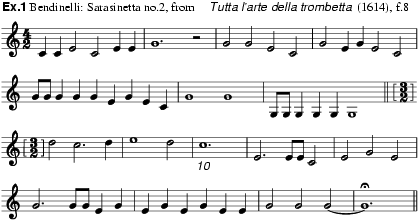
English term used during the 16th century and early 17th to indicate a monophonic trumpet signal. Sennet is synonymous with a number of contemporaneous terms found in continental Europe: ‘sersseneda’ in Denmark, ‘Serosonet’ in Germany, and ‘sarasinetta’ in Italy. These were probably derived from an Italian compound noun which combined ‘ser[en]o’ with ‘sonata’, meaning a piece of instrumental music associated with the greatest nobility. Markham (1639) included the ‘Senet for State’ among a number of signals ‘that have reference to the greatest Officers’; stage directions of late Elizabethan and Jacobean plays (documented from 1584 to 1619 and even later) associated the sounding of the sennet with the ceremonial entrance or exit of actors taking the roles of great lords; and Shakespeare reserved the signal for kings, heirs to the throne, emperors and great leaders.
Cesare Bendinelli included two sennets in his Tutta l’arte della trombetta (1614) (ex.1), one of which is also found among Magnus Thomsen's six sennets (DK-Kk Gl.kgl.Saml.1875a). They were written in the trumpet's triadic register. The form varied according to the occasion for which the sennet was composed; Bendinelli stated that sennets could be ‘long or short, and adopted for all situations’. Some of the surviving sennets include two sections, others four; a third type is very long and borrows the compositional form of the trumpet ensemble sonata, but not the latter's homorhythmic performance manner. The final section of a sennet normally begins with a short extemporized melismatic passage, as shown in bars 8–10 of ex.1: Thomsen indicated this in musical shorthand on the single pitch c'' ex.2.


For bibliography see Tuck, tucket; see also Flourish; Signal (i); and Sonata, §I.
EDWARD H. TARR, PETER DOWNEY